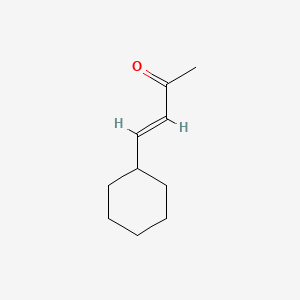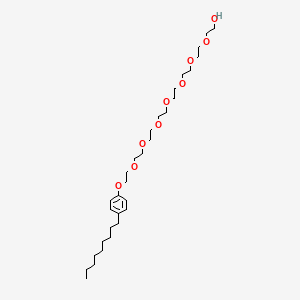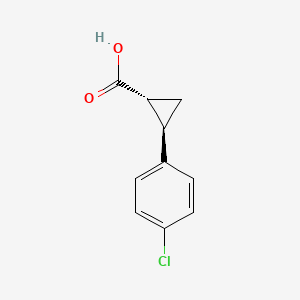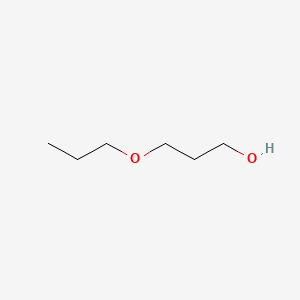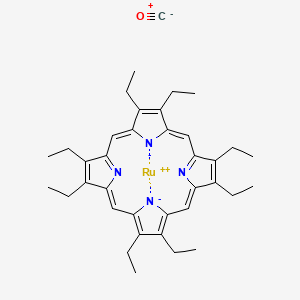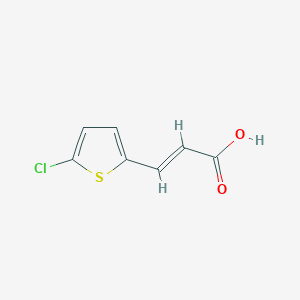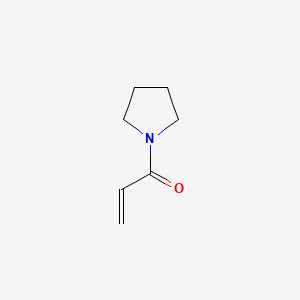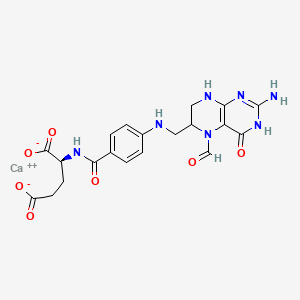
CID 135738681
- Klicken Sie auf QUICK INQUIRY, um ein Angebot von unserem Expertenteam zu erhalten.
- Mit qualitativ hochwertigen Produkten zu einem WETTBEWERBSFÄHIGEN Preis können Sie sich mehr auf Ihre Forschung konzentrieren.
Übersicht
Beschreibung
The compound with the identifier “CID 135738681” is a chemical entity listed in the PubChem database. It is characterized by its unique molecular structure and properties, which make it of interest in various scientific fields.
Vorbereitungsmethoden
Synthetic Routes and Reaction Conditions
The preparation of CID 135738681 involves specific synthetic routes. One such method includes reacting 2-fluoro-4-substituted phenylacetic acid with a Vilsmeier reagent, followed by quenching the reaction solution in an aqueous solution to obtain an intermediate . This intermediate is then further processed to yield the final compound.
Industrial Production Methods
Industrial production methods for this compound typically involve large-scale synthesis using optimized reaction conditions to ensure high yield and purity. The exact details of these methods are often proprietary and may vary between manufacturers.
Analyse Chemischer Reaktionen
Types of Reactions
CID 135738681 undergoes various chemical reactions, including:
Oxidation: This reaction involves the addition of oxygen or the removal of hydrogen.
Reduction: This reaction involves the addition of hydrogen or the removal of oxygen.
Substitution: This reaction involves the replacement of one atom or group of atoms with another.
Common Reagents and Conditions
Common reagents used in these reactions include oxidizing agents like potassium permanganate, reducing agents like lithium aluminum hydride, and various nucleophiles for substitution reactions. The conditions for these reactions typically involve controlled temperatures and pH levels to ensure the desired outcome.
Major Products
The major products formed from these reactions depend on the specific reagents and conditions used. For example, oxidation may yield carboxylic acids, while reduction may produce alcohols.
Wissenschaftliche Forschungsanwendungen
CID 135738681 has a wide range of applications in scientific research:
Chemistry: It is used as a reagent in various organic synthesis reactions.
Biology: It serves as a tool for studying biochemical pathways and molecular interactions.
Medicine: It is investigated for its potential therapeutic effects and as a lead compound in drug development.
Industry: It is utilized in the production of specialty chemicals and materials.
Wirkmechanismus
The mechanism of action of CID 135738681 involves its interaction with specific molecular targets and pathways. It may bind to enzymes or receptors, modulating their activity and leading to various biological effects. The exact molecular targets and pathways can vary depending on the context of its use.
Vergleich Mit ähnlichen Verbindungen
Similar Compounds
Similar compounds to CID 135738681 include other fluorinated phenylacetic acid derivatives and related chemical entities. These compounds share structural similarities but may differ in their specific functional groups and properties.
Uniqueness
What sets this compound apart from similar compounds is its unique combination of functional groups and molecular structure, which confer specific reactivity and biological activity. This uniqueness makes it a valuable compound for targeted research and applications.
Conclusion
This compound is a versatile compound with significant importance in various scientific fields. Its unique properties and reactivity make it a valuable tool for research and industrial applications.
Eigenschaften
CAS-Nummer |
41927-89-3 |
|---|---|
Molekularformel |
C20H31CaN7O12 |
Molekulargewicht |
601.6 g/mol |
IUPAC-Name |
calcium;(2S)-2-[[4-[(2-amino-5-formyl-4-oxo-3,6,7,8-tetrahydropteridin-6-yl)methylamino]benzoyl]amino]pentanedioate;pentahydrate |
InChI |
InChI=1S/C20H23N7O7.Ca.5H2O/c21-20-25-16-15(18(32)26-20)27(9-28)12(8-23-16)7-22-11-3-1-10(2-4-11)17(31)24-13(19(33)34)5-6-14(29)30;;;;;;/h1-4,9,12-13,22H,5-8H2,(H,24,31)(H,29,30)(H,33,34)(H4,21,23,25,26,32);;5*1H2/q;+2;;;;;/p-2/t12?,13-;;;;;;/m0....../s1 |
InChI-Schlüssel |
NPPBLUASYYNAIG-ZIGBGYJWSA-L |
SMILES |
C1C(N(C2=C(N1)N=C(NC2=O)N)C=O)CNC3=CC=C(C=C3)C(=O)NC(CCC(=O)O)C(=O)O.O.O.O.O.O.[Ca] |
Isomerische SMILES |
C1C(N(C2=C(N1)N=C(NC2=O)N)C=O)CNC3=CC=C(C=C3)C(=O)N[C@@H](CCC(=O)[O-])C(=O)[O-].O.O.O.O.O.[Ca+2] |
Kanonische SMILES |
C1C(N(C2=C(N1)N=C(NC2=O)N)C=O)CNC3=CC=C(C=C3)C(=O)NC(CCC(=O)[O-])C(=O)[O-].O.O.O.O.O.[Ca+2] |
Verwandte CAS-Nummern |
58-05-9 (Parent) |
Löslichkeit |
DMSO « 1 (mg/mL) H2O 100 (mg/mL) 0.1 N NaOH < 20 (mg/mL) |
Herkunft des Produkts |
United States |
Retrosynthesis Analysis
AI-Powered Synthesis Planning: Our tool employs the Template_relevance Pistachio, Template_relevance Bkms_metabolic, Template_relevance Pistachio_ringbreaker, Template_relevance Reaxys, Template_relevance Reaxys_biocatalysis model, leveraging a vast database of chemical reactions to predict feasible synthetic routes.
One-Step Synthesis Focus: Specifically designed for one-step synthesis, it provides concise and direct routes for your target compounds, streamlining the synthesis process.
Accurate Predictions: Utilizing the extensive PISTACHIO, BKMS_METABOLIC, PISTACHIO_RINGBREAKER, REAXYS, REAXYS_BIOCATALYSIS database, our tool offers high-accuracy predictions, reflecting the latest in chemical research and data.
Strategy Settings
| Precursor scoring | Relevance Heuristic |
|---|---|
| Min. plausibility | 0.01 |
| Model | Template_relevance |
| Template Set | Pistachio/Bkms_metabolic/Pistachio_ringbreaker/Reaxys/Reaxys_biocatalysis |
| Top-N result to add to graph | 6 |
Feasible Synthetic Routes
Haftungsausschluss und Informationen zu In-Vitro-Forschungsprodukten
Bitte beachten Sie, dass alle Artikel und Produktinformationen, die auf BenchChem präsentiert werden, ausschließlich zu Informationszwecken bestimmt sind. Die auf BenchChem zum Kauf angebotenen Produkte sind speziell für In-vitro-Studien konzipiert, die außerhalb lebender Organismen durchgeführt werden. In-vitro-Studien, abgeleitet von dem lateinischen Begriff "in Glas", beinhalten Experimente, die in kontrollierten Laborumgebungen unter Verwendung von Zellen oder Geweben durchgeführt werden. Es ist wichtig zu beachten, dass diese Produkte nicht als Arzneimittel oder Medikamente eingestuft sind und keine Zulassung der FDA für die Vorbeugung, Behandlung oder Heilung von medizinischen Zuständen, Beschwerden oder Krankheiten erhalten haben. Wir müssen betonen, dass jede Form der körperlichen Einführung dieser Produkte in Menschen oder Tiere gesetzlich strikt untersagt ist. Es ist unerlässlich, sich an diese Richtlinien zu halten, um die Einhaltung rechtlicher und ethischer Standards in Forschung und Experiment zu gewährleisten.


